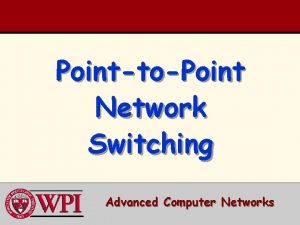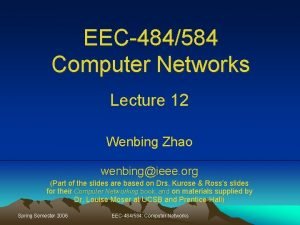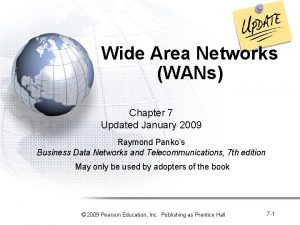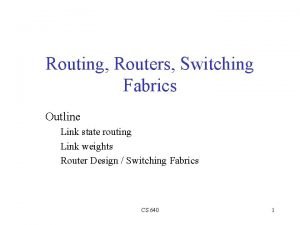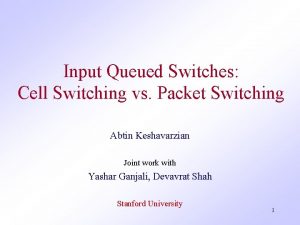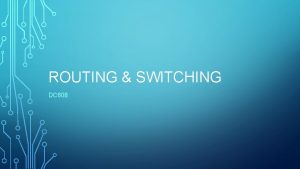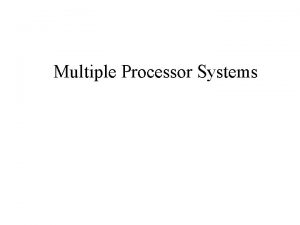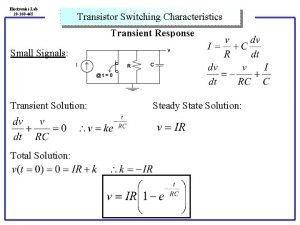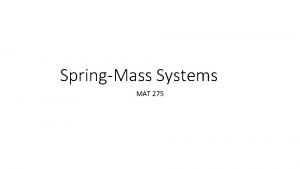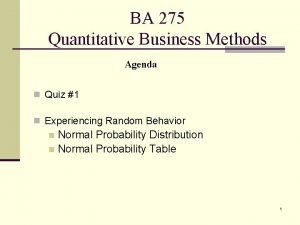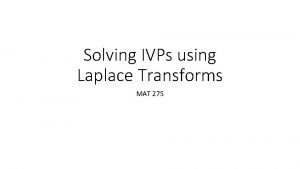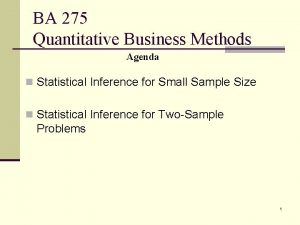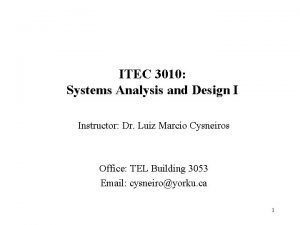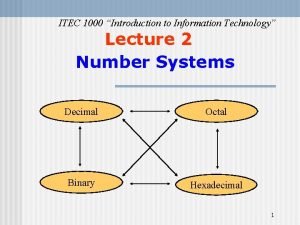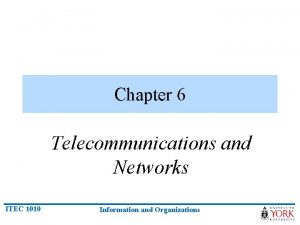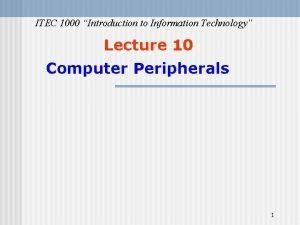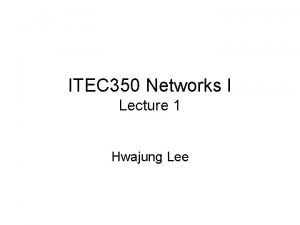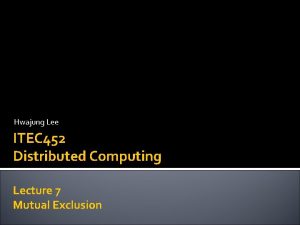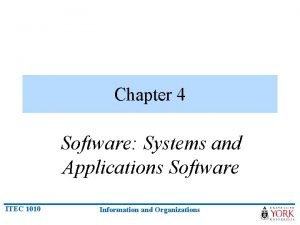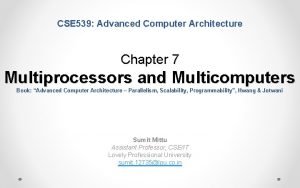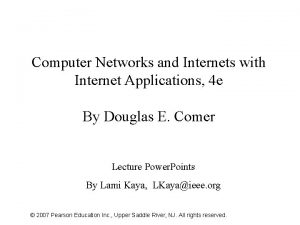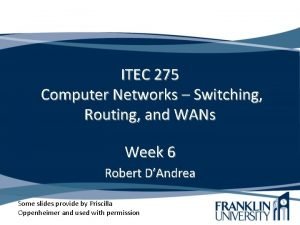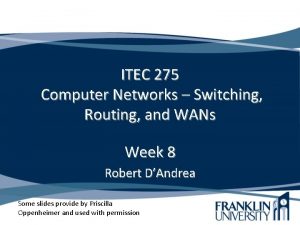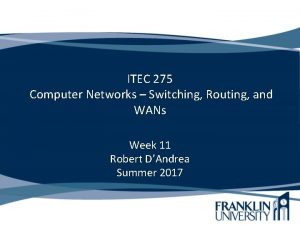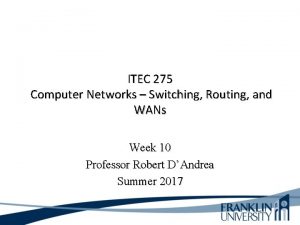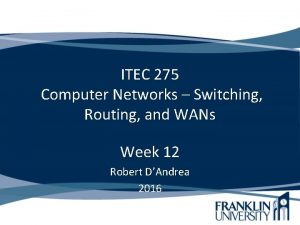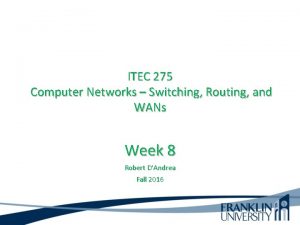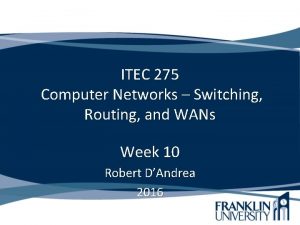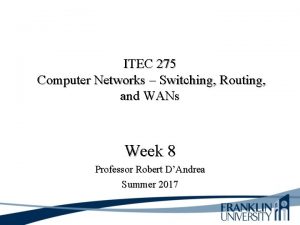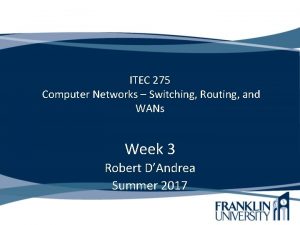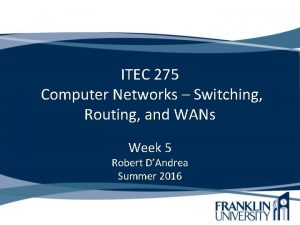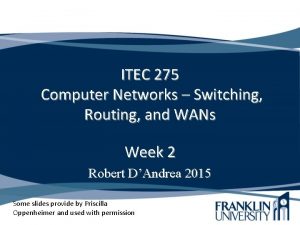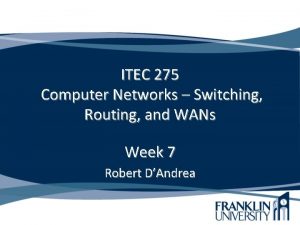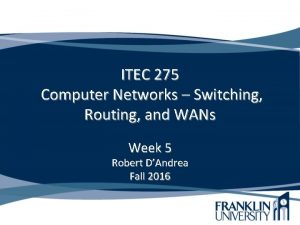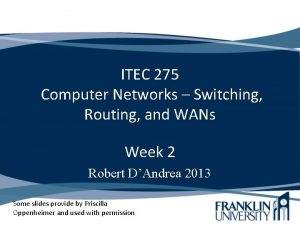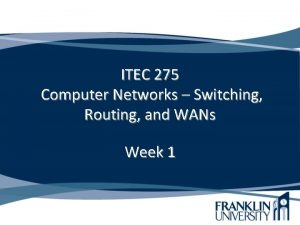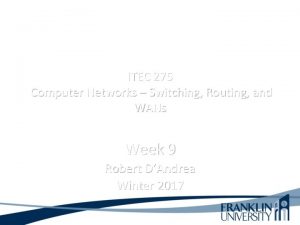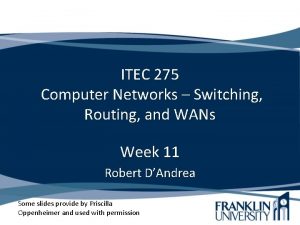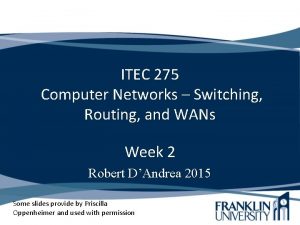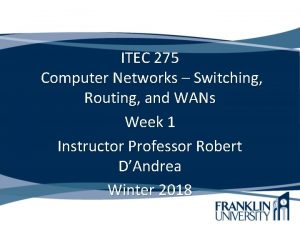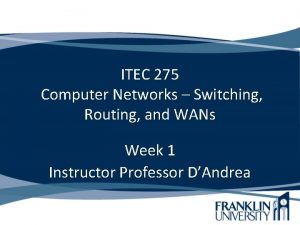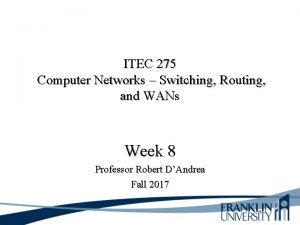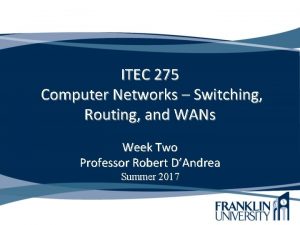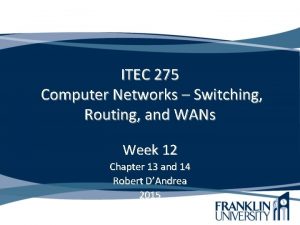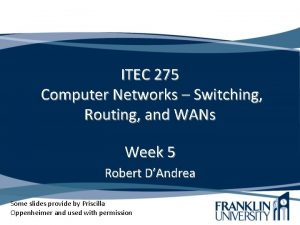ITEC 275 Computer Networks Switching Routing and WANs














































































- Slides: 78

ITEC 275 Computer Networks – Switching, Routing, and WANs Week 6 Robert D’Andrea Some slides provide by Priscilla Oppenheimer and used with permission

Agenda • Learning Activities – IP Addressing – Static and Dynamic Assignment – IPv 6 – IPv 4 to IPv 6 Transition Methods

Guidelines for Addressing and Naming • Use a structured model for addressing and naming. A topology may would be useful for viewing the hierarchy in the network and recognize address boundaries. • Assign addresses and names hierarchically • Decide in advance if you will use – Central or distributed authority for addressing and naming. Who is in charge of delegating addresses and naming conventions. – Public or private addressing (IANA or RFC 1918) – Static or dynamic addressing and naming (DHCP Dynamic Host Configuration Protocol)

Advantages of Structured Models for Addressing & Naming • It makes it easier to – Read network maps – Operate network management software – Recognize devices in protocol analyzer traces – Meet goals for usability – Design filters on firewalls and routers – Implement route summarization The Structured Model for addressing provides IP addresses meaning, hierarchical, and planned.

Public IP Addresses • Managed by the Internet Assigned Numbers Authority (IANA) • Users are assigned IP addresses by Internet service providers (ISPs). • ISPs obtain allocations of IP addresses from their appropriate Regional Internet Registry (RIR) Internet Assigned Numbers Authority (IANA). IANA allocates IP addresses to the Regional Internet Registries (RIRs)

Regional Internet Registries (RIR) • American Registry for Internet Numbers (ARIN) serves North America and parts of the Caribbean. • RIPE Network Coordination Centre (RIPE NCC) serves Europe, the Middle East, and Central Asia. • Asia-Pacific Network Information Centre (APNIC) serves Asia and the Pacific region. • Latin American and Caribbean Internet Addresses Registry (LACNIC) serves Latin America and parts of the Caribbean. • African Network Information Centre (Afri. NIC) serves Africa.

Criteria for Using Static Vs. Dynamic Addressing • • • The number of end systems The likelihood of needing to renumber The need for high availability Security requirements The importance of tracking addresses Whether end systems need additional information – (DHCP can provide more than just an address)

Criteria for Using Static Vs. Dynamic Addressing • IPv 6 Dynamic addressing supports both static and dynamic addressing -Dynamic addressing is referred to as auto -configuration and is made up of two components. Part 1: Stateful auto-configuration method, hosts retrieve addresses and other information from a server set up with a database.

Criteria for Using Static Vs. Dynamic Addressing Part 2: Stateless autoconfiguration method, a hosts generates it’s own address using locally available information. This includes advertised information from routers. The process starts by generating a link-local address for an interface. This involves combining the well-known linklocal prefix (FE 80: : /10) with a 64 bit interface identifier.

Criteria for Using Static Vs. Dynamic Addressing Link-local address is useful in the context of a single link or network. IPv 6 link-local addresses can be configured automatically on an interface by using the link-local prefix (FE 80: /10). Link-local addresses serve as a way for connecting devices on the same local network without the need for globally unique addresses. A router utilizing IPv 6 must not forward packets that have either link-local source or destination address.

Criteria for Using Static Vs. Dynamic Addressing Link-local addresses are used in neighbor discovery and in stateless autoconfiguration process.

The Two Parts of an IP Address 32 Bits Prefix Length Host

Prefix Length • An IP address is accompanied by an indication of the prefix length – Subnet mask – /Length • Examples – 192. 168. 10. 1 255. 0 – 192. 168. 10. 1/24

Subnet Mask • 32 bits long • Specifies which part of an IP address is the network/subnet field and which part is the host field – The network/subnet portion of the mask is all 1 s in binary. – The host portion of the mask is all 0 s in binary. – Convert the binary expression back to dotted-decimal notation for entering into configurations. • Alternative – Use slash notation (for example /24) – Specifies the number of 1 s

Subnet Mask Example • 11111111 0000 • What is this in slash notation? • What is this in dotted-decimal notation?

Subnet Mask Example • 11111111 0000 • What is this in slash notation? /24 • What is this in dotted-decimal notation? 255. 0

Another Subnet Mask Example • 111111110000 • What is this in slash notation? • What is this in dotted-decimal notation?

Another Subnet Mask Example • 111111110000 • What is this in slash notation? /20 • What is this in dotted-decimal notation? 255. 240. 0

One More Subnet Mask Example • 11111111000 0000 • What is this in slash notation? • What is this in dotted-decimal notation?

One More Subnet Mask Example • 11111111000 0000 • What is this in slash notation? 21 • What is this in dotted-decimal notation? 255. 248. 0

Private and Public Addresses Figure 6 -1

Network Address Translation (NAT) • Static – One private address to one public address – Used for servers that must be visible to the public network • Dynamic – Many unregistered addresses to one registered address from a pool of addresses – Used for workstations that only connect to the public network when required • Combination – Used by most organizations

Network Address Translation (NAT) • Problem with Private Addressing Outsourcing network management responsibilities to an outside vendor. With private addressing, the internal networks are not advertised to the outside. NAT problems would occur handling network management protocols like Simple Network Management Protocol (SNMP).

Network Address Translation (NAT) • Simple Network Management Protocol (SNMP). Enterprise networks are heterogeneous. In addition to multi-tiered applications, a critical part of the infrastructure consists of network devices and other applications that are vendor specific. However, these devices normally have a Simple Network Management Protocol (SNMP) agent (interface) and this facilitates SNMP monitoring.

Address use in the Enterprise Figure 6 -3

Designing Networks with Subnets • Determining subnet size • Computing subnet mask • Computing IP addresses

Determinations • How many locations? – How many segments are required? • How many devices? – How large must each segment be? • What are the IP addressing requirements for each location? – Is public access required? • What subnet size is appropriate? – Determined by first and second questions

Addresses to Avoid When Subnetting • • A node address of all ones (broadcast) A node address of all zeros (network) A subnet address of all ones (all subnets) A subnet address of all zeros (confusing) – Cisco IOS configuration permits a subnet address of all zeros with the ip subnet-zero command

IP Subnet-Zero • Under old IP subnetting rules, the all 0’s subnet was reserved for the network, and the all 1’s subnet was reserved for the broadcast. Over time, engineers found that the all 0’s subnet wasn’t really used and, if it could be handed out as a useable network, many IP addresses could be changed.

Practice Network is 172. 16. 0. 0 You want to divide the network into subnets. You will allow 600 nodes per subnet. What subnet mask should you use? What is the address of the first node on the first subnet? • What address would this node use to send to all devices on its subnet? • • •

Practice • Network is 172. 16. 0. 0 • You want to divide the network into subnets. 64 • You will allow 600 nodes per subnet. 1022 • What subnet mask should you use? 255. 252. 0 (/22) • What is the address of the first node on the first subnet? 172. 16. 0. 1 • What address would this node use to send to all devices on its subnet? 172. 16. 3. 255

More Practice • Network is 172. 16. 0. 0 • You have eight LANs, each of which will be its own subnet. • What subnet mask should you use? • What is the address of the first node on the first subnet? • What address would this node use to send to all devices on its subnet?

More Practice • Network is 172. 16. 0. 0 • You have eight LANs, each of which will be its own subnet. • What subnet mask should you use? 255. 224. 0 (/19) • What is the address of the first node on the first subnet? 172. 16. 0. 1 • What address would this node use to send to all devices on its subnet? 172. 16. 31. 255

One More Network is 192. 168. 55. 0 You want to divide the network into subnets. You will have approximately 25 nodes per subnet. What subnet mask should you use? What is the address of the last node on the last subnet? • What address would this node use to send to all devices on its subnet? • • •

One More • Network is 192. 168. 55. 0 • You want to divide the network into subnets. 8 • You will have approximately 25 nodes per subnet. 30 • What subnet mask should you use? 255. 224 (/27) • What is the address of the last node on the last subnet? 192. 168. 255. 254 • What address would this node use to send to all devices on its subnet? 192. 168. 255

Alternate Method How many subnets? 2^x – 2 = number of subnets. X is the number of masked bits, or the 1 s. Example: 11000000 (2^2 – 2) = (4 – 2 = 2) subnets

Alternate Method How many hosts per subnet? 2^ - 2 = number of hosts per subnet. X is the number of unmasked bits, or the 0 s (64 -2 = 62) hosts per subnet Example: 11000000 (2^6 – 2) = 62 hosts per subnet What are the valid subnets? Network address: 192. 168. 10. 0 255. 192 (11000000) 256 – 192 = 64 is the first subnet. 64 + 64 = 128 + 64 = 192 Two valid subnets are 64 and 128

Alternate Method What is the broadcast address for each subnet? 127 and 191 What are the valid hosts? The subnets 64 128 192 The first host 65 129 The last host 126 190 The broadcast address 127 191

IP Address Classes • Classes are now considered obsolete • But you have to learn them because – Everyone in the industry still talks about them! – You may run into a device whose configuration is affected by the classful system

IP Address Classes • Traditional routing, is known as classful routing. No information is transmitted about the prefix length. The hosts and router examine the first three bits of the IP address to determine its class. Class A All network addresses 0 xxxxxxx 0000 = 0 01111111 = 127

IP Address Classes Class B 10000000 = 128 10111111 = 191 Class C 11000000 = 192 11011111 = 223

IP Address Classes • Classless Interdomain Routing (CIDR) notation identifies the prefix length with a length field, followed by a slash. Example: 10. 1/16 The prefix length is 16 bits long. The subnet mask is 255. 0. 0.

Classful IP Addressing Class First Byte Few Bits Prefix Intent Length A B C D E 0 10 1110 1111 Very large networks Large networks Small networks IP multicast Experimental 1 -126* 128 -191 192 -223 224 -239 240 -255 8 16 24 NA NA *Addresses starting with 127 are reserved for IP traffic local to a host.

Division of the Classful Address Space Class Prefix Number of Addresses Length per Network A B C 8 16 24 224 -2 = 16, 777, 214 216 -2 = 65, 534 28 -2 = 254

Classful IP is Wasteful • • Class A uses 50% of address space Class B uses 25% of address space Class C uses 12. 5% of address space Class D and E use 12. 5% of address space

Classless Addressing • Prefix/host boundary can be anywhere • Less wasteful • Supports route summarization – Also known as • • • Aggregation Supernetting Classless routing Classless inter-domain routing (CIDR) Prefix routing

Classless Addressing • Classless routing protocols transmit a prefix length with the IP address. This allows classless routing protocols to group networks into one entry and use the prefix length to specify which networks are grouped. • Classless routing protocols include RIPv 2, EIGRP, OSPF, BGP, and IS-IS.

Definitions • Subnetting is when you take one large network and break it into a bunch of smaller networks. • A subnet mask is a 32 -bit value that allows the recipient of IP packets to distinguish the network ID portion of the IP address from the host ID portion of the IP address. The 1 s in the subnet mask represent the position referred to as the network or subnet addresses.

Routing Protocols • Distance vector finds the best path to a remote network by judging distance. Each time the packet goes through a router, that’s called a hop. • Link State, also called shortest path first protocols, The router each create three separate tables. One to keep track of directly attached neighbors. A second table to determine the topology of the entire internetwork. The third table is used as a routing table.

Supernetting 172. 16. 0. 0 172. 17. 0. 0 172. 18. 0. 0 Branch-Office Router 172. 19. 0. 0 Branch-Office Networks • • Move prefix boundary to the left Branch office advertises 172. 16. 0. 0/14 Enterprise Core Network

Addressing Hierarchy Figure 6 -6 – Page 387

Route summarization • Summary 192. 168. 0/21 Figure 6 -5 – Page 386

172. 16. 0. 0/14 Summarization First Octet in Decimal First Octet in binary 172 10101100 Second Octet in Decimal Binary Second Octet in 16 00010000 17 0001 18 00010010 19 00010011

Private Addressing • 10. 0 – 10. 255 • 172. 16. 0. 0 – 172. 31. 255 • 192. 168. 0. 0 – 192. 168. 255

Discontiguous Subnets Area 0 Network 192. 168. 49. 0 Router A Area 1 Subnets 10. 108. 16. 0 10. 108. 31. 0 Router B Area 2 Subnets 10. 108. 32. 0 10. 108. 47. 0

Discontiguous Subnets Router A advertises access to network 10. 0. Router B ignores the advertisement because it can already get to network 10. 0. This occurs in both directions with the routers. Classless routing protocol is one method for solving this problem.

A Mobile Host • Mobile Host is a host that moves from one network to another and has a statically defined IP address. The administrator can move a mobile host to another and configure a router with a host-specific route to specify that traffic for the host should be routed through that router. Classless routing protocols match the longest prefix. Example: 10. 108. 16. 0/20 and 10. 108. 16. 1/32

A Mobile Host Router A Router B Subnets 10. 108. 16. 0 10. 108. 31. 0 Host 10. 108. 16. 1

IPv 6 • A technology developed to overcome the limitations of the current standard, IPv 4 • Combines expanded addressing with a more efficient and feature-rich header to improve scaling • Satisfies the increasingly complex requirements of hierarchical addressing that IPv 4 does not support

IPv 6 Features • Larger address space: – – IPv 6 addresses are 128 bits, compared to IPv 4's 32 bits Allows more support for addressing hierarchy levels A much greater number of addressable nodes Simpler auto-configuration of addresses • Globally unique IP addresses: – Every node can have a unique global IPv 6 address – Eliminates the need for NAT. • Site multi-homing: – IPv 6 allows hosts to have multiple IPv 6 addresses – Allows networks to have multiple IPv 6 prefixes – Sites can have connections to multiple ISPs without breaking the global routing table

• • IPv 6 Features (continued) Header format efficiency: – A simplified header with a fixed header size makes processing more efficient. Improved privacy and security: – IPsec is the IETF standard for IP network security, available for both IPv 4 and IPv 6. Although the functions are essentially identical in both environments, IPsec is mandatory in IPv 6 also has optional security headers. Flow labeling capability: – A new capability enables the labeling of packets belonging to particular traffic flows for which the sender requests special handling, such as nondefault quality of service (Qo. S) or real-time service. Increased mobility and multicast capabilities: – Mobile IPv 6 allows an IPv 6 node to change its location on an IPv 6 network and still maintain its existing connections. With Mobile IPv 6, the mobile node is always reachable through one permanent address. A connection is established with a specific permanent address assigned to the mobile node, and the node remains connected no matter how many times it changes locations and addresses

IPv 6 Address Format • The format is x: x: x, where x is a 16 -bit hexadecimal field – 2035: 0001: 2 BC 5: 0000: 087 C: 0000: 000 A • Leading 0 s within each set of four hexadecimal digits can be omitted, and a pair of colons (: : ) can be used, once within an address, to represent any number of successive 0 s. – 2035: 1: 2 BC 5: : 87 C: 0: A

IPv 6 Addresses • Link-local address: The host configures its own link-local address autonomously, using the link-local prefix FE 80: : 0/10 and a 64 -bit identifier for the interface, in an EUI-64 format. • Stateless autoconfiguration: A router on the link advertises—either periodically or at the host's request—network information, such as the 64 bit prefix of the local network and its willingness to function as a default router for the link. Hosts can automatically generate their global IPv 6 addresses by using the prefix in these router messages; the hosts do not need manual configuration or the help of a device such as a DHCP server. • Stateful using DHCP for IPv 6 (DHCPv 6): DHCPv 6 is an updated version of DHCP for IPv 4. DHCPv 6 gives the network administrator more control than stateless autoconfiguration and can be used to distribute other information, including the address of the DNS server. DHCPv 6 can also be used for automatic domain name registration of hosts using a dynamic DNS server. DHCPv 6 uses multicast addresses.

IPv 6 Aggregatable Global Unicast Address Format 3 13 8 FP TLA ID RES 24 NLA ID Public topology • • • FP TLA ID RES NLA ID SLA ID Interface ID 16 SLA ID 64 bits Interface ID Site Topology Format Prefix (001) Top-Level Aggregation Identifier Reserved for future use Next-Level Aggregation Identifier Site-Level Aggregation Identifier Interface Identifier

Upgrading to IPv 6 • Dual stack • Tunneling • Translation

Dual-Stack A dual-stack node enables both IPv 4 and IPv 6 stacks. Applications communicate with both IPv 4 and IPv 6 stacks; the IP version choice is based on name lookup and application preference. This is the most appropriate method for campus and access networks during the transition period, and it is the preferred technique for transitioning to IPv 6. A dual-stack approach supports the maximum number of applications. Figure 6 -24

Tunneling Figure 2 -25

Translation Dual-stack and tunneling techniques manage the interconnection of IPv 6 domains. For legacy equipment that will not be upgraded to IPv 6 and for some deployment scenarios, techniques are available for connecting IPv 4 -only nodes to IPv 6 -only nodes, using translation, an extension of NAT techniques.

Guidelines for Assigning Names • Names should be – Short – Meaningful – Unambiguous – Distinct – Case insensitive • Avoid names with unusual characters – Hyphens, underscores, asterisks, and so on

Domain Name System (DNS) • Maps names to IP addresses • Supports hierarchical naming – example: frodo. rivendell. middle-earth. com • A DNS server has a database of resource records (RRs) that maps names to addresses in the server’s “zone of authority” • Client queries server – Uses UDP port 53 for name queries and replies – Uses TCP port 53 for zone transfers

DNS Details • Client/server model • Client is configured with the IP address of a DNS server – Manually or DHCP can provide the address • DNS resolver software on the client machine sends a query to the DNS server. Client may ask for recursive lookup.

DNS Recursion • A DNS server may offer recursion, which allows the server to ask other servers – Each server is configured with the IP address of one or more root DNS servers. • When a DNS server receives a response from another server, it replies to the resolver client software. The server also caches the information for future requests. – The network administrator of the authoritative DNS server for a name defines the length of time that a nonauthoritative server may cache information.

Summary • Use a systematic, structured, top-down approach to addressing and naming • Assign addresses in a hierarchical fashion • Distribute authority for addressing and naming where appropriate • IPv 6 looms in our future

Review Questions • Why is it important to use a structured model for addressing and naming? • When is it appropriate to use IP private addressing versus public addressing? • When is it appropriate to use static versus dynamic addressing? • What are some approaches to upgrading to IPv 6?

This Week’s Outcomes • • IP Addressing Static and Dynamic Assignment IPv 6 IPv 4 to IPv 6 Transition Methods

Due this week • 5 -1 – Concept questions 4 • 1 -5 -1 – Network design project – Switches

Next week • Read chapters 7 in Top-Down Network Design • 6 -1 – Concept questions 5 • Franklin. Live session 7

Q&A • Questions, comments, concerns?
 Circuit switching packet switching message switching
Circuit switching packet switching message switching Data link layer switching in computer networks
Data link layer switching in computer networks Https://speakerdeck.com/
Https://speakerdeck.com/ Cell switching in computer networks
Cell switching in computer networks Virtual circuit switching example
Virtual circuit switching example Packet switched network vs circuit switched network
Packet switched network vs circuit switched network Computer networks routing algorithms
Computer networks routing algorithms Broadcast routing in computer networks
Broadcast routing in computer networks 7th wans
7th wans Routing and switching protocols
Routing and switching protocols Abderazek ben abdallah
Abderazek ben abdallah 325181028 routing
325181028 routing Routing and switching protocols
Routing and switching protocols Cell switching vs packet switching
Cell switching vs packet switching Packet switching system
Packet switching system Cell switching vs packet switching
Cell switching vs packet switching Channel routing and reservoir routing
Channel routing and reservoir routing Mark tinka
Mark tinka Continuity equation hydrology
Continuity equation hydrology Routing in physical design
Routing in physical design Routing switching adalah
Routing switching adalah Backbone networks in computer networks
Backbone networks in computer networks Uma multiprocessors using multistage switching networks
Uma multiprocessors using multistage switching networks Transistor switching networks
Transistor switching networks Scott surgent asu
Scott surgent asu Lb to kg equation
Lb to kg equation 275 e main st frankfort ky
275 e main st frankfort ky Dpr 8 marzo 1999 n 275
Dpr 8 marzo 1999 n 275 Praça antonio prado, 48 rua xv de novembro, 275
Praça antonio prado, 48 rua xv de novembro, 275 Ba 275
Ba 275 Mat 275
Mat 275 Panjang sebatang besi adalah 275 m, setara dengan...
Panjang sebatang besi adalah 275 m, setara dengan... Rdc 275
Rdc 275 Ba 275
Ba 275 Projet terminale sti2d itec
Projet terminale sti2d itec Ad systems exam slide
Ad systems exam slide Itec 4010
Itec 4010 Itec 3220
Itec 3220 Zona de subduccion
Zona de subduccion Itec 3220
Itec 3220 Itec 3220
Itec 3220 Itec 1000
Itec 1000 Exponent mantissa
Exponent mantissa Itec 1000
Itec 1000 Itec 1000
Itec 1000 Itec 1000
Itec 1000 Itec 1010
Itec 1010 Itec exam results
Itec exam results Itec 3010
Itec 3010 Itec 1000
Itec 1000 Itec irrigation controller
Itec irrigation controller Itec 350
Itec 350 Itec
Itec Itec
Itec Cs itec
Cs itec Itec
Itec Nic borg
Nic borg Duolingo fecha de lanzamiento
Duolingo fecha de lanzamiento Itec software
Itec software Message routing schemes in computer architecture
Message routing schemes in computer architecture Integrated services vs differentiated services
Integrated services vs differentiated services Checksum in computer networks with example
Checksum in computer networks with example Byte stuffing and bit stuffing
Byte stuffing and bit stuffing Difference between character stuffing and bit stuffing
Difference between character stuffing and bit stuffing Arp rarp protocol
Arp rarp protocol Analog and digital signals in computer networking
Analog and digital signals in computer networking Http computer networks
Http computer networks Computer networks and internets with internet applications
Computer networks and internets with internet applications Error detection and correction in networking
Error detection and correction in networking Protocols and standards in computer networks
Protocols and standards in computer networks Error detection in computer networks
Error detection in computer networks Computer networks and internets
Computer networks and internets Crc in computer networks
Crc in computer networks Crc in computer networks
Crc in computer networks Traffic management in computer networks
Traffic management in computer networks Speed of a computer
Speed of a computer What is optimality principle in computer networks
What is optimality principle in computer networks Snmp supports which formatted protocol
Snmp supports which formatted protocol What is optimality principle in computer networks
What is optimality principle in computer networks



